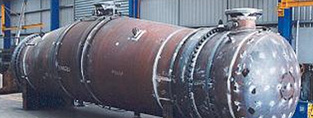
- (03) 5909 8218
- enquiry@fusionweld.com.au
How Gas Leaks from Pressure Vessels Can Be Prevented
September 27, 2017

As we've mentioned on numerous occasions, gas leaks from pressure vessels are either immediately destructive or slowly poisonous. Inimical to public safety, the gaseous compounds starve respiratory systems of oxygen. They combust or act as corrosive airborne poisons. Even a best-case scenario suggests irreparable environmental damage if a leak occurs, so how do we prevent gas leaks? We'll hold back on that answer until we've talked about on-site operations.
Observing the Design Specifications
Pressure vessels are stable and reliable storage containers. However, they're not immune to damage, not if the storage or processing system is operating beyond the vessels' safety limits. All engineering products are designed with inbuilt handling tolerances. In this environment, we're talking about massive pressures, but there's also an accompanying set of temperature highs and lows that require containment parameters. No matter the processing layout or storage architecture, those engineering tolerances must be observed. If this rule is ignored, a gas leak is not only likely, it's imminent.
Establishing Inspection Procedures
In factory checks and on-site inspections must be conducted at project's end and according to an intelligently determined maintenance program. Those checks evaluate the usual system fixtures, including the safety valves that protect the pressure vessel from transient load events. Additionally, visual inspections and electronic instruments are called in to assess the viability of the weld seams and the vessel shell. In the latter check, the structure of the alloy sheeting is microscopically scanned for invisible material defects.
On-site Protection Solutions
A gas monitor alarm is an essential pressure vessel emergency aid. Initiated by a sensed gas leak, the alarm warns on-site personnel of a pressure vessel breach, then a shut-down valve or pressure release system is operated so that the leak is quickly isolated. Other site protection systems are mandated here, including a negative pressure environment control system and an independent venting policy that works with sprinkling equipment to stop the leak spreading. Again, these solutions are designed as a last resort, one that can't guarantee containment. A leak prevention strategy, on the other hand, stops the hazard from ever taking place.
Valve seals and pipe joints, system gaskets and conduit flanges form an operational frame around pressure vessels. The gaskets and fasteners seal the containment network so that a gas conveyance leak does not occur. As for the pressure vessel itself, all weld seams and sheet metal materials must be inspected according to a nationally accredited set of governing standards, such as the AS 4343, a series of engineering guidelines that assesses every conceivable design feature, even when the pressure vessel is operating on-site.
Contact Details
Fusion - Weld Engineering Pty Ltd
ABN 98 068 987619
1865 Frankston Flinders Road,
Hastings, VIC 3915
Ph: (03) 5909 8218
Optimized by NetwizardSEO.com.au
Recent Posts
- Compressed Hydrogen Storage Vessels: Material Selection, Design & Australian Standards
- Welding QA/QC in Oil & Gas Pressure Vessel Fabrication – Ensuring Code Compliance
- AS1210 vs ASME VIII Pressure Vessel Code: Key Differences for Australian Projects
- Mitigating Hydrogen-Induced Cracking in Pressure Vessels: Engineering and Material Strategies
- Storage Tank Solutions Australia: Field-Erected, Prefabricated & Self-Bunded Explained
- Reducing Environmental Risks: Self-Bunded Tanks in Australian Oil & Gas Operations
- Precision in Production: How Pressure Vessels Are Manufactured for Industrial Safety
- Shell & Tube Heat Exchangers: Improve Thermal Control & Energy Recovery in Petrochemical & Pharmaceutical Plants
- In-Service Inspection for Compressed Air Receivers for Power Plant Shutdown Prevention
- Power Plant Pipe Spooling Fabrication – Get Rapid, Code-Compliant Spools Ready for Installation
- Field Erected Tanks: Safe, Reliable On-Site Fuel Storage Solutions in Australia
- Custom Pressure Vessel Fabrication for Flammable Gases
Posts 2025
- Compressed Hydrogen Storage Vessels: Material Selection, Design & Australian Standards
- Welding QA/QC in Oil & Gas Pressure Vessel Fabrication – Ensuring Code Compliance
- View all articles…
Posts 2024
- Large Process Vessels: Optimising the Design for Maximum Efficiency [2025]
- Pressure Equipment Management System Installation: Detect Equipment Faults Early
- View all articles…
Posts 2023
- Pressure Piping System Inspection: A Gift of Safety for the Holidays
- Deaerator Inspections by Fusion-Weld Engineering and How They Reduce System Downtime
- View all articles…
Posts 2022
- How Fusion Weld Keeps Up With AS-NZS ISO 9001:2008 Standard
- Boiler Equipment Safety Inspection During the Summer Season
- View all articles…
Posts 2021
- Avoid These Factors and Practices that Contribute to Sealing Damage in Pressure Vessels
- Do's And Don'ts Of Industrial Boiler Inspection And Maintenance From Fusion-Weld
- View all articles…
Posts 2020
- What are the Risks and Hazards Involved in Pressure Vessel Equipment?
- How to Know if Your Pressure Equipment Needs Repair or Replacement?
- View all articles…
Posts 2019
- Factors that Contribute to Pressure Vessel Failure
- Pressure Vessel Regulations in Australia: What are the Mandatory Requirements?
- View all articles…
Posts 2018
- Pros and Cons of Spherical vs. Cylindrical Pressure Vessels
- What are the Different Hazard Levels in Pressure Vessels?
- View all articles…
Posts 2017
- Transportable Pressure Vessels: The Importance of Inspection and Safety Checks
- Fracture Mechanics and Stress Analysis of Cracks in Pressure Vessels
- View all articles…
Posts 2016
Posts 2015
- What Are Deaerators & Feedwater Vessels?
- Precautions and Safety for Compressed Air Receiver Vessels
- View all articles…
Posts 2014
- Demonstrating In-process Inspection Procedures
- Static Grounding Practices and Standards
- View all articles…